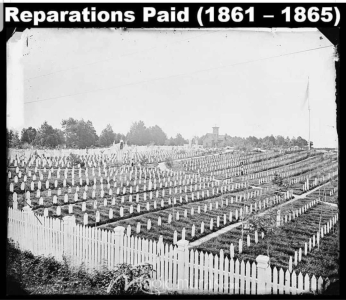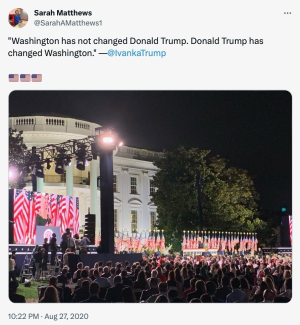And a reminder. When a Ky town clerk refused to issue gay marriage license because it violated state law.... they arrested her without trial and threatened to keep her there until she issued the license.
-
Pat Flood (@rebarcock) passed away 9/21/25. Pat played a huge role in encouraging the devolopmemt of this site and donated the very first dollar to get it started. Check the thread at the top of the board for the obituary and please feel free to pay your respects there. I am going to get all the content from that thread over to his family so they can see how many people really cared for Pat outside of what they ever knew. Pat loved to tell stories and always wanted everyone else to tell stories. I think a great way we can honor Pat is to tell a story in his thread (also pinned at the top of the board).
You are using an out of date browser. It may not display this or other websites correctly.
You should upgrade or use an alternative browser.
You should upgrade or use an alternative browser.
Master Thread Dance Your Cares Away/Fraggle/Law Abiding Citizens
- Thread starter Bryan74b
- Start date
Master Threads
Is that Vindeman on the left?

Russia: the civilian population in Palestine can’t be bombed, but in Ukraine it can. Turkey: 4M Palestinians have the right to their own state, but 40M Kurds do not.Egypt: we worry about the Palestinians, but we won’t let them in.Houthis of Yemen: our country is in complete devastation, but we will fight Israel. Western leftists & LGBT activists: Palestinians are wonderful peaceful people, but we won’t go to them, they’ll kill us there.Hamas: we should not take care of the residents of Gaza, let the UN take care of them.You can’t make this stuff up…

SmokeHouse423
Elite
Most Americans are disgusting to look at

Nigeria massacre sees over 100 Christians dead: ‘Killed for sport’
More than 52,000 Christians “have been butchered or hacked to death for being Christians” since 2009 in Nigeria, according to Intersociety, a civil society group based in Onitsha.

Maine Dem who booted Trump from ballot met with Biden, called Electoral College ‘white supremacy’
Maine Secretary of State Shenna Bellows, who moved to boot former President Donald Trump off the state’s Republican primary ballot, previously met with President Biden this year at the White …

Man fatally shot by MTA cops was parolee with 12 prior arrests — and armed with an Uzi: authorities
The man MTA cops fatally shot in Queens was an armed parolee who had been carrying an Uzi after groping a woman, authorities said.
I miss the UGA fans from 1982 thru 2021, good times!Be nice.
Jake Broe Stan
Elite
Of course there is going to be negotiations. How else do you think Ukrainian reparations and war crimes trials for Russians will take place?
Jake Broe Stan
Elite
AFU had another great day at the office. 1,000 orcs eliminated and a 7:1 equipment destruction ratio!
Slava America! Slava Ukraini!
Slava America! Slava Ukraini!
Goldhedge
Legendary
Hair is not regulation...
Jake Broe Stan
Elite
Killing Russians By The Truckload Around Avdiivka, Ukraine’s M-2 Fighting Vehicles Are Showing How Russia Loses—And Ukraine Wins

Killing Russians By The Truckload Around Avdiivka, Ukraine’s M-2 Fighting Vehicles Are Showing How Russia Loses—And Ukraine Wins
Russia is counting on staying in the war for the long term. That’s its whole plan for victory. A plan a few battalions of Ukrainian vehicles have exposed as a farce.
 www.forbes.com
www.forbes.com
On Oct. 10, elements of two Russian field armies—together possessing 40,000 troops and thousands of vehicles—attacked the Ukrainian garrison in Avdiivka, just northwest of Russian-occupied Donetsk in eastern Ukraine’s Donbas region.
It was the first and main attack of Russia’s third annual winter offensive in its 22-month wider war on Ukraine. And it failed.
More accurately, it has been failing. The Russian operation around Avdiivka is ongoing. But after advancing a short distance—a mile or so—north and south of the city last month, the Russian 2nd and 41st Combined Arms Armies at best have stalled. Some analysts believe they actually are losing ground around the village of Stepove on Avdiivka’s northern flank.
It’s no secret that Moscow’s new strategy is to outlast Kyiv—to win a war of attrition. But the Russians can’t win a war of attrition if they continue to lose many more vehicles and troops than the Ukrainians lose.
In that context, the battle for Avdiivka has been a disaster for Russia. It’s exactly the kind of fight the Kremlin can’t afford if its goal is to grind away Ukraine’s military strength. Around Avdiivka, it’s the Russians who are getting ground down.
The numbers tell the story. The Russian field armies have lost at least 411 tanks, fighting vehicles and artillery pieces trying, and failing, to capture Avdiivka. The Ukrainian brigades garrisoning Avdiivka—including the 110th, 57th and 47th Mechanized and the 1st Tank—have lost just 30 pieces of heavy equipment.
Russian casualties—dead and maimed—exceed 13,000 in just this one sector. Ukraine’s own casualties likely have been much lighter. Perhaps a few thousand.
Yes, the Russian army in Ukraine—at least 400,000 strong—is larger than Ukraine’s own front-line force is. Yes, Russia can mobilize many more replacement troops than Ukraine can mobilize. Yes, Russian industry out-produces Ukrainian industry.
No, Russia’s resources are not limitless.
This is apparent in Avdiivka, where the Russians repeatedly have switched up tactics in order to preserve one portion of their force or another. In October, Russian attacks around Avdiivka were heavily mechanized, with tanks and fighting vehicles leading the way.
When the tanks and fighting vehicles ran afoul of Ukrainian mines, drones and artillery, Russian commanders pulled back their remaining vehicles—and sent in the infantry, on foot. When the infantry got massacred, the Russians deployed more explosives-laden drones in an effort to sever Ukrainian forces’ supply lines.
That didn’t work, either. Yesterday, Ukrainian president Volodymyr Zelensky himself safely traveled to Avdiivka—and shot a selfie within view of the front line.
The most recent Russian attacks on Avdiivka have included tanks and infantry. But in the most critical northern part of the battlefield, in and around Stepove, the conditions—for the Russians—are unforgiving.
It’s there in Stepove that the Ukrainian 47th Brigade, with its mix of American-made M-2 Bradley fighting vehicles and German-made Leopard 2 tanks, is killing Russians by the truckload.
To the east, Stepove abuts east-west treelines and a north-south railway. “Ukraine is using the railroad treelines to isolate Stepove from the rest of the battlefield,” analyst Donald Hill wrotein fellow analyst Tom Cooper’s newsletter.
“As Russian troops and vehicles move out from [neighboring] Krasnohorivka across the open fields, Ukrainian artillery and drones reduce their numbers,” Hill explained. “They remain under fire until the assault loses momentum and stops.”
“Ukraine then counterattacks, sometimes with Leopards—and often with Bradleys raking the treelines with 25-millimeter cannon fire. Bradleys also transport small assault teams that clear out Russian stragglers from time to time. Once Stepove and the treelines by the railroad are clear, or mostly clear, of Russian troops, Ukraine pulls back to their functional defensive positions and waits for the next Russian attack.”
“Constantly pushing the Russians back helps preserve the defensive positions Ukraine currently occupies,” Hill explained. “This tactic is much easier for the 47th Brigade to use because of the firepower of the Bradley, which can engage Russian armor and has done so, and its cannon fire is very effective against Russian infantry even when they are in cover.”
The 30-ton, 11-person M-2 with its side-mounted reactive armor effectively resists Russian rocket-propelled grenades. “This not only keeps the crew alive, it gives them the confidence to aggressively attack the Russians, which makes a huge difference,” Hill wrote.
The 47th Brigade got all 190 M-2s that the United States pledged to the Ukrainian war effort early this year. The brigade has lost at least 30 M-2s. But it needs just a hundred of the vehicles fully to equip its battalions.
All that is to say, the 47th Brigade isn’t hurting for firepower. And it’s found the perfect place to use it: Avdiivka. More specifically, Stepove. The Russians keep sending men and vehicles for the M-2 crews to chop to pieces.
This is not a winning strategy for Russia. The Kremlin can build, and restore from long-term storage, at most 1,500 tanks and a couple thousand fighting vehicles a year.
Taking into account the need to backfill losses from 2022, Russian forces can afford to lose at most 50 tanks a month without depleting their overall armor holdings. The Avdiivka fight lately has pushed the Russians’ armor losses well above sustainable levels.
The Kremlin drafted 300,000 fresh troops this year but, amid protests and labor-shortages, hasn’t yet begun a second mobilization.
Extreme losses—at least 315,000 killed or severely wounded in 22 months—have contributed to what the RAND Corporation, a California think-tank, described as a “ticking social time-bomb” in Russia, a country with just 143 million people.
Ukraine, a country with 44 million people, also has lost a lot of soldiers: at least 70,000 killed and several times that number wounded. But in recent months the loss ratio—Russian losses compared to Ukrainian losses—greatly has favored Ukraine. Around Avdiivka, it might be 10 to one as those M-2 crews go about their bloody work.
Say what you will about Russia’s material and manpower advantages and Russian society’s appetite for a cruel war of choice. Russia cannot sustain the kinds of losses it has experienced in the battle for Avdiivka. Not over the long term.
And to be clear, Russia is counting on staying in the war for the long term. That’s its whole plan for victory. A plan that a few battalions of Ukrainian fighting vehicles have exposed as a farce.
Jake Broe Stan
Elite
Killing Russians By The Truckload Around Avdiivka, Ukraine’s M-2 Fighting Vehicles Are Showing How Russia Loses—And Ukraine Wins

Killing Russians By The Truckload Around Avdiivka, Ukraine’s M-2 Fighting Vehicles Are Showing How Russia Loses—And Ukraine Wins
Russia is counting on staying in the war for the long term. That’s its whole plan for victory. A plan a few battalions of Ukrainian vehicles have exposed as a farce.
 www.forbes.com
www.forbes.com
On Oct. 10, elements of two Russian field armies—together possessing 40,000 troops and thousands of vehicles—attacked the Ukrainian garrison in Avdiivka, just northwest of Russian-occupied Donetsk in eastern Ukraine’s Donbas region.
It was the first and main attack of Russia’s third annual winter offensive in its 22-month wider war on Ukraine. And it failed.
More accurately, it has been failing. The Russian operation around Avdiivka is ongoing. But after advancing a short distance—a mile or so—north and south of the city last month, the Russian 2nd and 41st Combined Arms Armies at best have stalled. Some analysts believe they actually are losing ground around the village of Stepove on Avdiivka’s northern flank.
It’s no secret that Moscow’s new strategy is to outlast Kyiv—to win a war of attrition. But the Russians can’t win a war of attrition if they continue to lose many more vehicles and troops than the Ukrainians lose.
In that context, the battle for Avdiivka has been a disaster for Russia. It’s exactly the kind of fight the Kremlin can’t afford if its goal is to grind away Ukraine’s military strength. Around Avdiivka, it’s the Russians who are getting ground down.
The numbers tell the story. The Russian field armies have lost at least 411 tanks, fighting vehicles and artillery pieces trying, and failing, to capture Avdiivka. The Ukrainian brigades garrisoning Avdiivka—including the 110th, 57th and 47th Mechanized and the 1st Tank—have lost just 30 pieces of heavy equipment.
Russian casualties—dead and maimed—exceed 13,000 in just this one sector. Ukraine’s own casualties likely have been much lighter. Perhaps a few thousand.
Yes, the Russian army in Ukraine—at least 400,000 strong—is larger than Ukraine’s own front-line force is. Yes, Russia can mobilize many more replacement troops than Ukraine can mobilize. Yes, Russian industry out-produces Ukrainian industry.
No, Russia’s resources are not limitless.
This is apparent in Avdiivka, where the Russians repeatedly have switched up tactics in order to preserve one portion of their force or another. In October, Russian attacks around Avdiivka were heavily mechanized, with tanks and fighting vehicles leading the way.
When the tanks and fighting vehicles ran afoul of Ukrainian mines, drones and artillery, Russian commanders pulled back their remaining vehicles—and sent in the infantry, on foot. When the infantry got massacred, the Russians deployed more explosives-laden drones in an effort to sever Ukrainian forces’ supply lines.
That didn’t work, either. Yesterday, Ukrainian president Volodymyr Zelensky himself safely traveled to Avdiivka—and shot a selfie within view of the front line.
The most recent Russian attacks on Avdiivka have included tanks and infantry. But in the most critical northern part of the battlefield, in and around Stepove, the conditions—for the Russians—are unforgiving.
It’s there in Stepove that the Ukrainian 47th Brigade, with its mix of American-made M-2 Bradley fighting vehicles and German-made Leopard 2 tanks, is killing Russians by the truckload.
To the east, Stepove abuts east-west treelines and a north-south railway. “Ukraine is using the railroad treelines to isolate Stepove from the rest of the battlefield,” analyst Donald Hill wrotein fellow analyst Tom Cooper’s newsletter.
“As Russian troops and vehicles move out from [neighboring] Krasnohorivka across the open fields, Ukrainian artillery and drones reduce their numbers,” Hill explained. “They remain under fire until the assault loses momentum and stops.”
“Ukraine then counterattacks, sometimes with Leopards—and often with Bradleys raking the treelines with 25-millimeter cannon fire. Bradleys also transport small assault teams that clear out Russian stragglers from time to time. Once Stepove and the treelines by the railroad are clear, or mostly clear, of Russian troops, Ukraine pulls back to their functional defensive positions and waits for the next Russian attack.”
“Constantly pushing the Russians back helps preserve the defensive positions Ukraine currently occupies,” Hill explained. “This tactic is much easier for the 47th Brigade to use because of the firepower of the Bradley, which can engage Russian armor and has done so, and its cannon fire is very effective against Russian infantry even when they are in cover.”
The 30-ton, 11-person M-2 with its side-mounted reactive armor effectively resists Russian rocket-propelled grenades. “This not only keeps the crew alive, it gives them the confidence to aggressively attack the Russians, which makes a huge difference,” Hill wrote.
The 47th Brigade got all 190 M-2s that the United States pledged to the Ukrainian war effort early this year. The brigade has lost at least 30 M-2s. But it needs just a hundred of the vehicles fully to equip its battalions.
All that is to say, the 47th Brigade isn’t hurting for firepower. And it’s found the perfect place to use it: Avdiivka. More specifically, Stepove. The Russians keep sending men and vehicles for the M-2 crews to chop to pieces.
This is not a winning strategy for Russia. The Kremlin can build, and restore from long-term storage, at most 1,500 tanks and a couple thousand fighting vehicles a year.
Taking into account the need to backfill losses from 2022, Russian forces can afford to lose at most 50 tanks a month without depleting their overall armor holdings. The Avdiivka fight lately has pushed the Russians’ armor losses well above sustainable levels.
The Kremlin drafted 300,000 fresh troops this year but, amid protests and labor-shortages, hasn’t yet begun a second mobilization.
Extreme losses—at least 315,000 killed or severely wounded in 22 months—have contributed to what the RAND Corporation, a California think-tank, described as a “ticking social time-bomb” in Russia, a country with just 143 million people.
Ukraine, a country with 44 million people, also has lost a lot of soldiers: at least 70,000 killed and several times that number wounded. But in recent months the loss ratio—Russian losses compared to Ukrainian losses—greatly has favored Ukraine. Around Avdiivka, it might be 10 to one as those M-2 crews go about their bloody work.
Say what you will about Russia’s material and manpower advantages and Russian society’s appetite for a cruel war of choice. Russia cannot sustain the kinds of losses it has experienced in the battle for Avdiivka. Not over the long term.
And to be clear, Russia is counting on staying in the war for the long term. That’s its whole plan for victory. A plan that a few battalions of Ukrainian fighting vehicles have exposed as a farce.
dirty022
Elite
Similar threads
- Replies
- 13
- Views
- 475
- Replies
- 0
- Views
- 2K
- Replies
- 56
- Views
- 4K
- Replies
- 113
- Views
- 9K










